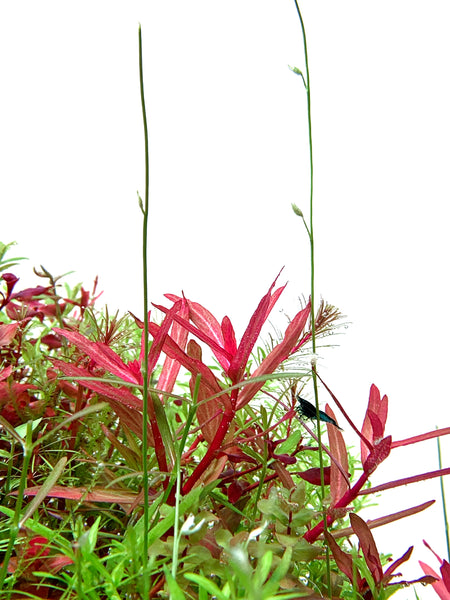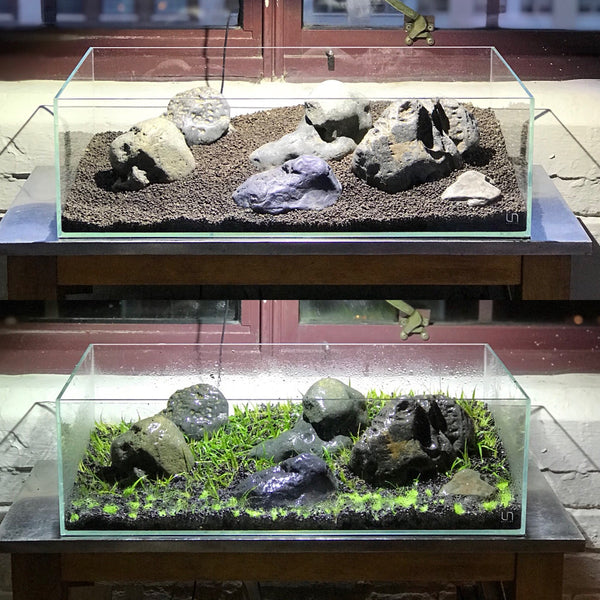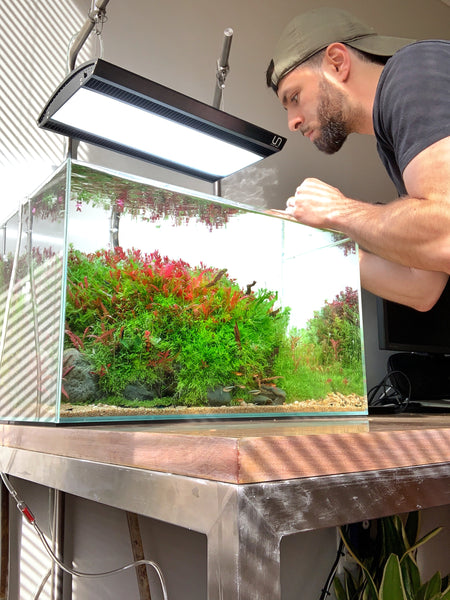
9 Common Planted Aquarium Mistakes to Avoid
Having trouble finding a good balance in your new tank? Can’t understand why your plants won’t take off, but algae is thriving? Setting up a successful planted tank is supposed to be fun, but it can be frustrating when things don’t turn out as planned. I made many errors when I set up my first few aquascapes back in 2015, and I see plenty of people facing similar challenges online. I hope that the following list of mistakes to avoid will help everything go more smoothly! In no particular order:

-
NOT ENOUGH WATER CHANGES
If I had a tattoo, it would say “water changes are key.” Many algae problems are quickly resolved by simply increasing water change frequency. For a high tech planted tank with fish, you should do at least two 30% water changes each week. For a sparsely stocked planted low tech tank, you can get away with once a week. I personally do a 25-30% water change three times a week. (Learn more about the importance of water changes by clicking here)
-
NOT USING ENOUGH PLANTS DURING SETUP
This one is not so obvious. Why would one spend extra time (and potentially money) heavily planting a new tank, when it will just fill in any way? While it would be great if things were this simple, it can actually take quite a while for a sparsely planted tank to fill in. In the meantime, algae will be able to benefit from the lack of competition for light and nutrients, and can potentially take over. Plus, the tank will look underplanted for an unnecessarily long time. That’s why it’s best to cover as many square inches as possible with aquarium plants. When setting up a new tank, I tend to leave just a centimeter or two between each plant, at most.
-
USING TOO MUCH SUBSTRATE
Think about some of your favorite planted aquascapes. What makes those scapes look so professional and put-together? In addition to great plant choices, bushy growth and harmonious hardscape, a more subtle point they probably share is relatively thin substrate at the front of the tank. At most, the substrate along the front of the glass should typically be 3 cm tall (for my fellow Americans, this is less than 1.5 inches). For an even classier look, depending on preference, you can have an infinitesimally thin layer of sand at the front (natural, larger grained sand, not white pool filter sand), rising in height as it moves further back in the tank and meets the actual substrate. To my eyes, a fat line of substrate at the front of the tank looks like amateur hour.
-
OVERSTOCKING THE TANK
Any seasoned (or really even not so seasoned) fishkeeper will caution you about overstocking a tank; in addition to putting too much stress on the fish, it allows dangerous quantities of nitrogenous and organic waste to quickly accumulate. In the planted aquarium, where fertilizer is also being added, this can be an effective formula for cultivating an algae farm. Overcrowding is stressful for the fish and fishkeeper alike!
-
USING TOO MUCH FERTILIZER
Plants need some sort of nutrition, usually in the form of fertilizer. But how much do they really need? If you have an enriched substrate, the answer is far less than you might think. When I set up a new tank, I like to wait a few weeks before adding any fertilizer at all (to keep algae under control). Then I slowly add a small amount of All-in-One liquid fertilizer here and there, increasing if an occasional plant leaf starts to show yellow leaves or tiny holes. If I start to get algae growth beyond what is normal, I will correspondingly scale back the fertilizer. Better to have one or two yellow leaves (hit the sweet spot and you won’t) than hair algae soup.
-
PLANTING STEMS TOO FAR APART AND NOT TRIMMING ENOUGH
Have you ever looked at a tank (maybe even your own) and felt that something was not quite right, at least visually? Besides the previously discussed thick substrate thing, another common visual pitfall is having widely spaced, string-like stem plants. As mentioned, it is preferable to plant very densely; it is a myth that plants need a very wide berth to “breathe” or to get enough light. In addition, if left untrimmed, stem plants will not typically form branches. But with each trim, most stem plants will grow two buds right below where the cut was made. By letting these buds grow a while and then trimming each of their ends, the effect is almost exponential, and soon a branching bush will be formed. This technique, compounded with dense planting from the start, is what creates that bushy, healthy look that that characterizes the tanks of professional aquascapers and skilled hobbyists. -

-
ROCKY DIORAMA AND GIMMICK TANKS
Just because you could theoretically make a tank that resembles the CGI scenery from the movie Avatar doesn’t mean you should. Tricky even in the hands of a professional aquascaper, things can turn out much worse in your average Joe’s living room. It’s great to be creative, and I don’t believe in rigid aquascaping layout rules. Just watch out- beyond the contrived nature of such setups, a heavy focus on rocky hardscape at the expense of plantable areas often results in algae overgrowth. I prefer a more natural-looking, heavily planted approach.
-
USING AN UNDERSIZED AQUARIUM FILTER
For a high tech, high nutrient tank, a small filter can really hold you back. It’s better to go oversized; check out the UNS Delta line of filters by clicking here. The extra volume of filtration media in the tank provides more surface area for beneficial bacteria to thrive, and the good turnover of water ensures that the tank is well oxygenated and has good flow throughout. However, if the filter is too small you run the risk of having stunted growth and algae issues (not to mention the danger posed to livestock).
-
TRUSTING FORUM POSTS
It’s cliche to say this, but be careful about believing everything you read on forums. There are many helpful, successful aquascapers out there, eager to share helpful knowledge; the problem is that they often have very different methods for achieving the same level of success. For example, mixing and matching different components of the E.I. method with the ADA method will likely result in an algae party due to lack of balance. Unfortunately, the nature of forum posts is those incompatible bits of advice that are often presented in close proximity to each other. Compounded by other posts offering objectively incorrect advice, this can be a very confusing situation for newcomers seeking clear information. My tip is to find someone whose work you admire, and then follow their methods exactly. That way you will have a clear framework to operate under and build off of, instead of a haphazard, heterogeneous approach.
Tell us - Was this article helpful? Please leave a comment below!
If you have any questions regarding this article, please DM us on Instagram, Facebook, or email support@buceplant.com so we can assist you - @buceplant









Comments
Leave a comment